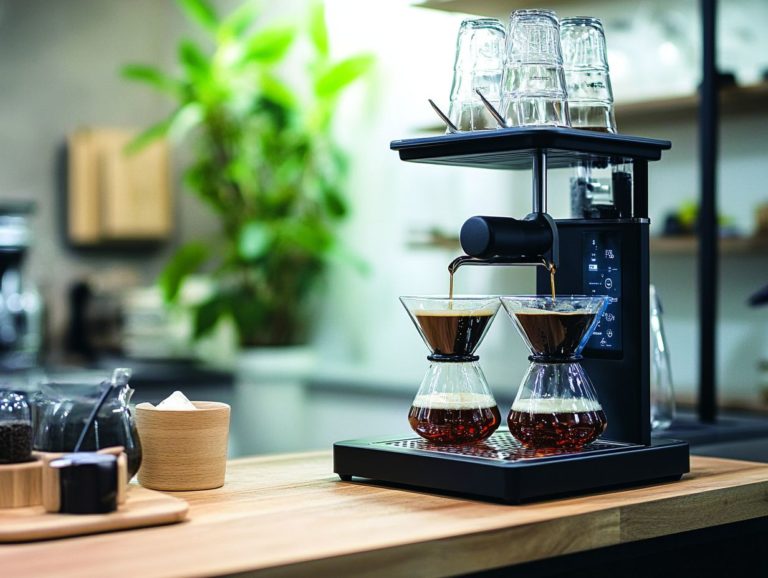The Ultimate Guide to Brewing on a Budget
Homebrewing is a thrilling and creative adventure that lets you create your own unique beers right in the comfort of your kitchen or a dedicated homebrew station. However, it can escalate in cost if you re not mindful of your spending.
This guide walks you through the essentials of brewing at home, outlining the necessary brewing equipment and ingredients while offering budget-friendly tips to help you keep expenses in check.
You ll learn how to select quality ingredients without breaking the bank, steer clear of common pitfalls that new brewers frequently encounter, and uncover clever strategies to elevate your homebrewing experience.
Whether you re a seasoned brewer or just starting your journey, you ll find valuable insights here that will empower you to craft delicious beer without overspending, even if you are working on a small batch!
Contents
Key Takeaways:
- Invest in essential equipment and ingredients to get started with homebrewing.
- Buy malt, hops, and yeast in bulk to save on costs, and take advantage of deals and discounts, including those found on Facebook Marketplace.
- Avoid common mistakes like not properly calculating costs and overcomplicating the brewing process. Keep it simple and experiment with different styles.

The Basics of Homebrewing
To truly understand the art of homebrewing, you ll need to familiarize yourself with various brewing methods, including all-grain brewing and the brew-in-a-bag technique, alongside essential equipment like brew kettles, carboys, and fermentation vessels.
Essential Brewing Techniques
Selecting the right ingredients is pivotal; you’ll be working with malt, hops, yeast, and water to achieve your desired flavor profile. Whether you re aiming to perfect a classic Irish stout or venture into the bold flavors of a Russian imperial stout, the choices you make will shape your brew into something truly special, possibly even a crisp session beer.
What Equipment Do You Need?
When you start brewing, having the right brewing equipment is absolutely essential for a successful experience, ensuring that your beer is crafted to perfection and tastes exceptional.
To create a smooth brewing process, you ll want to consider various tools like brew kettles, which not only allow you to boil your ingredients but also help you maintain precise temperature control during the mash.
Fermentation vessels, such as carboys and buckets, are crucial as they provide the ideal environment for yeast to work its magic, transforming sugars into alcohol. Consider using an all-in-one system like the Grainfather, Anvil Foundry, or Robobrew for an integrated brewing experience.
Tools like digital thermometers are invaluable, guaranteeing that the temperature stays within the optimal range throughout brewing. Immersion chillers, including DIY immersion chillers, play their part by efficiently cooling down the wort quickly, preventing any potential contamination.
Each piece of equipment is significant in contributing to the quality and consistency of your finished beer, ensuring that every batch is truly worth celebrating.
What Ingredients Do You Need?
The foundation of any exceptional beer lies in its ingredients, and grasping which elements you need for homebrewing is essential for crafting high-quality craft beer.
The key components you ll want to focus on are malt and hops, each playing a vital role in the brewing process. Malt, typically derived from barley, supplies the sugars necessary for fermentation and contributes to the beer’s color and body. Hops are your secret weapon for balancing sweetness with bitterness, imparting a range of flavors and aromas that can vary from floral to citrusy.
Yeast is the magical organism that transforms the sugars from malt into alcohol while also influencing the final taste through its unique fermentation characteristics. And let s not forget water it may often be overlooked, but it constitutes the majority of your beer and can significantly impact the brewing process and flavor profile.
By selecting high-quality ingredients and understanding how they interact, you can elevate your home brewing craft, resulting in a well-balanced and flavorful final product.
Start brewing today!
Choosing the Right Ingredients
Choosing the right ingredients for home brewing is a pivotal step that can profoundly influence both the taste and quality of your beer and your overall brewing experience.
From selecting the ideal malt that supplies the essential sugars for fermentation to choosing the right hops that lend bitterness and aroma, every ingredient holds significant importance in the brewing process.
Understanding different yeast varieties is crucial, as they are responsible for fermentation, transforming sugar into alcohol and adding distinctive flavors that define various beer styles.
Embracing this knowledge not only enhances your brewing prowess but also elevates your entire craft to a new level of sophistication.
How to Save Money on Malt
Saving money on malt without sacrificing the quality of your homebrewed beer is not just a dream; it s a goal well within your reach that allows you to stick to your budget while enjoying the homebrewing experience.
One effective strategy is to purchase malt in bulk. This method makes brewing easier and saves you money while allowing you to stock up on essential ingredients for a variety of beer styles.
Alternatively, you might consider utilizing malt extract instead of going all-grain. This approach can simplify the brewing process and cut costs, all while still delivering exceptional flavor. Consider checking Facebook Marketplace for deals on bulk malt and other brewing supplies.
Exploring local suppliers is also a wise move, as they may offer competitive prices or discounts for loyal customers. Keep in mind that malt is a crucial element that shapes the character and depth of flavor in your beers. Striking the right balance between cost and quality is essential for achieving that perfect brew without breaking the bank. For sanitizing your equipment, consider using StarSan, a reliable and cost-effective option.
How to Save Money on Hops

Hops are an essential ingredient in brewing, but they can also take a significant bite out of your budget. To keep your costs in check without compromising on flavor, it’s crucial to explore smart strategies.
One effective cost-saving approach is to purchase hops in bulk. This simple shift can dramatically reduce the price per ounce compared to those smaller packages that seem to vanish all too quickly. Consider opting for hop pellets instead of whole hops; these little powerhouses are compressed to save space and deliver a concentrated burst of flavor and aroma, making them an ideal choice for efficient brewing.
Don t underestimate the value of connecting with local suppliers or browsing various online marketplaces. You might just uncover some competitive prices or even seasonal sales that make a difference. Plus, understanding the different types of hops, like Citra or Cascade, along with their unique flavor profiles whether citrusy, floral, or piney enables you to make informed choices that enhance your beer and keep your costs down.
How to Save Money on Yeast
Yeast is the essential catalyst in fermentation, transforming your wort into beer, and finding ways to save on yeast can significantly enhance your home brewing budget.
By exploring various cost-effective methods, you can not only save money but also refine your brewing techniques. For example, using yeast from your last batch to ferment a new one is a popular strategy, allowing you to maximize the potential of the yeast multiple times.
Choosing dry yeast over liquid yeast offers added convenience and a longer shelf life. Local brew shops typically feature a variety of yeast strains tailored to different beer styles, making it crucial for you to select the right strain to achieve your desired flavor profile. This approach not only cuts costs but also enriches your overall brewing experience.
Tips for Budget-Friendly Brewing
Brewing exceptional beer at home doesn t need to be a costly endeavor. With a bit of thoughtful planning and creativity, you can craft delightful brews without straining your budget, ensuring significant savings along the way.
Try these tips today to maximize your brewing budget and enjoy great beer!
Save Money on Home Brewing
1. Buy in Bulk
One of the most effective ways for you to save money in home brewing is to buy your ingredients in bulk. This can lead to significant savings over time.
When you purchase bulk quantities of malt, hops, and yeast, you not only cut down on your overall costs per batch but also secure a steady supply for your upcoming projects. This strategy keeps you prepared and prevents those costly last-minute buys!
Many online retailers and local suppliers offer competitive pricing and discounts for bulk orders, making it easier for you to stock up. Breweries and specialty shops typically provide various package sizes, allowing you to tailor your purchases to fit your specific needs.
Explore these options to take advantage of reduced expenses while always having your essential ingredients on hand for your brewing adventures.
2. Reuse Equipment and Ingredients
Using practical strategies to recycle equipment and ingredients can lead to significant savings for you as a home brewer while simultaneously enhancing the sustainability of your brewing process.
Utilize fermentation vessels and brewing kettles multiple times to trim costs and minimize your impact on the environment. Cleaning and sanitizing your tools after each use extends their lifespan and ensures that each new batch remains uncontaminated. Using a digital thermometer during this process can also help maintain consistency.
Consider repurposing leftover ingredients from your previous brews, such as hops or grains and barley. This approach minimizes waste and can add unique flavors to your new creations. Even reusing yeast, which you can harvest from the fermentation process, helps maintain an effective working culture while reducing your reliance on store-bought alternatives. Brew-in-a-bag methods are also an excellent way to maximize ingredient usage.
By embracing these sustainable practices, you contribute to a more environmentally friendly approach to beer production that benefits both your wallet and our planet. Craft beer enthusiasts will appreciate the unique brews made from your eco-friendly methods.
3. Look for Deals and Discounts
Discovering deals and discounts on brewing ingredients and equipment allows you to maximize your brewing budget, enabling you to invest in quality without overspending. This can lead to significant savings over time.
Start your search by diving into popular online marketplaces, such as Facebook Marketplace, where local sellers frequently list brewing supplies at enticing prices. This platform not only presents a diverse array of products but also cultivates a vibrant community among fellow brewers. This makes it easier to set up your homebrew station.
Be sure to visit your local homebrew shops, particularly during seasonal sales, as these opportunities can yield significant discounts on essentials like grains, hops, and fermenters. Look out for all-in-one systems like the Grainfather, Anvil Foundry, or Robobrew to streamline your brewing process.
Engaging with community groups or forums dedicated to home brewing proves invaluable for sharing deals and exchanging insights with others who share your passion. You’ll often find tips on creating your own DIY immersion chiller or on where to find the best prices for brewing equipment.
4. Experiment with Different Styles

Experimenting with different beer styles not only elevates your brewing skills but also provides a budget-friendly avenue for home brewing. Trying styles like Irish stout or Russian imperial stout can be particularly rewarding.
By exploring a variety of recipes, you can maximize leftover ingredients, turning what could have been waste into delightful, flavorful brews. This creative approach not only reduces waste but also ignites a sense of innovation and exploration in your brewing journey. Small batch brewing can be particularly useful for these experiments.
Each batch becomes your canvas, allowing unique flavors to emerge as you play with unexpected combinations and techniques. The thrill of discovery that comes with your experiments often leads to delightful surprises, enabling you to tailor your creations to your personal tastes and preferences transforming your brew day into an exhilarating adventure.
Ready to start brewing? Gather your ingredients and let the adventure begin!
Common Mistakes to Avoid
Avoiding common mistakes in home brewing is essential for achieving high-quality beer while keeping your budget intact. This not only enhances your brewing experience but also helps you focus on crafting your perfect brew!
1. Not Calculating Costs
One of the most significant mistakes you can make as a home brewer is neglecting to accurately calculate the costs tied to your brewing projects. This oversight can swiftly lead to overspending.
A clear understanding of each ingredient, including malt, hops, and yeast, is essential. When you skip the budgeting process, you may encounter unexpected expenses that disrupt your passion for crafting beer.
To avoid this pitfall, outline all potential costs upfront, including ingredients like malt, hops, and yeast, as well as essential equipment such as fermenters, bottles, and kegs. Don t forget to factor in utilities like water and electricity, as these can accumulate over time.
Tracking these costs helps you manage your brewing system efficiently. By carefully keeping track of these expenses, you can enjoy brewing without the stress of financial surprises. This also frees up funds to invest in advanced brewing equipment or try new techniques.
With a clear budget in place, you not only save money but also free up funds to explore exciting new recipes and brewing techniques.
2. Overcomplicating the Process
Home brewing can indeed be complex, yet a common misstep is overcomplicating the process and losing sight of the essentials.
This tendency can lead to frustration, robbing you of the sheer joy that comes with crafting your own beer. It s crucial to remember that brewing rests on fundamental principles; adhering to these can yield delightful results.
For beginners, it s wise to start with straightforward recipes, using a limited selection of ingredients to grasp how each component influences flavor and quality. As your confidence grows, gradually introduce new techniques and ingredients, enhancing your brewing experience.
Always prioritize cleanliness and temperature control, as these factors are vital for optimal results. Using tools like a digital thermometer helps maintain the right conditions. Embracing simplicity in the initial stages makes your brewing journey manageable and enjoyable.
3. Not Properly Cleaning and Sanitizing Equipment
Proper cleaning and sanitizing of your brewing equipment is a critical step that many home brewers often overlook, yet it is essential for producing high-quality beer.
The brewing process is influenced by many factors, and the cleanliness of your equipment plays a pivotal role in the overall outcome. Contamination can lead to off-flavors, spoilage, or even a complete failure of the brew disappointments you want to avoid at all costs!
To ensure your brewing success, it s vital to adopt effective cleaning practices. Start by rinsing your equipment thoroughly to remove any residue. Then, use a non-abrasive cleaner to scrub the surfaces, followed by a hot water rinse.
For even better results, consider using a DIY immersion chiller to cool your wort efficiently. Applying a sanitizer like StarSan, known for its effectiveness, will help eliminate pesky bacteria and wild yeasts.
This careful attention to hygiene safeguards your investment in equipment and ingredients while elevating the quality of your final product.
Frequently Asked Questions
What is ‘The Ultimate Guide to Brewing on a Budget’?

‘The Ultimate Guide to Brewing on a Budget’ is a comprehensive guide that provides tips and tricks for brewing your own beer at home without breaking the bank. Whether you’re using an all-grain method or experimenting with a session beer, this guide covers it all.
Brewing on a Budget
Why Brew on a Budget?
Brewing on a budget lets you save money while enjoying quality, homemade beer. It also encourages experimentation with ingredients and techniques without financial stress.
Tips for Budget Brewing
Buy ingredients in bulk and reuse equipment to save money. Explore affordable substitutes for expensive items.
Check out brewing systems like the Grainfather or Robobrew for efficient brewing.
Can You Brew Quality Beer on a Budget?
Absolutely! With the right techniques and quality ingredients, you can create delicious beer without splurging. Focus on great malt and hops to elevate your brew.
Saving Money on Brewing Equipment
Purchase used equipment, DIY certain pieces, or borrow from friends to cut costs. Always shop around for the best deals before buying.
Drawbacks of Budget Brewing
You might miss out on specialized equipment or ingredients. However, with creativity, you can brew great beer affordably. Consider investing in versatile tools like a carboy for multiple brewing stages.






